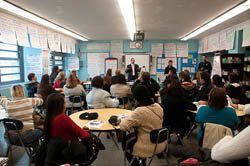Field Trip from Rio
Brazilian educators visit a stellar middle school run by a TC doctoral student and former Cahn Fellow
By Barbara Finkelstein
During a recent visit to Brazil, Brian Perkins, director of TC's Urban Education Leadership Program, told Rio de Janeiro Secretary of Education Claudia Costin about a Bronx middle school that’s achieving great things under its principal, Perkins protégé Ramon Gonzalez.
Thus in January, when Rio rewarded 39 of its most effective teachers and principals with an all-expenses-paid vacation in North America, Costin personally phoned Perkins to ask if he could arrange visits to the school – The Laboratory School of Finance and Technology (MS 233) – and to TC itself.
Perkins obliged, and the trips to 120th Street and 145th in the Bronx became the undisputed centerpiece of the group's North American idyll.
"We were amazed at the cooperation we saw between the pupils and teachers" said the group’s ad hoc translator, André Luis da Silva, Jr., a teacher from Paquetá Island 10, about 10 miles northeast of Rio. "But the truth is, we were asking each other, 'Is this school too good to be true?'"
Miracle on 145th Street
It’s an understandable question. Between 2003 and 2010, student math proficiency rates at MS 233 rose from 13 to 60 percent and English proficiency rates from 10 to 30 percent. If those numbers still seem low, consider that, as The New York Times wrote in an April 2011 feature story about Gonzalez (a graduate of the Cahn Fellows program, and a TC doctoral candidate), they nevertheless have established MS 233 –as the 10th best middle school in the entire city.
But even more impressive to the Brazilian educators, many of whom also wrestle with the consequences of crime, drug abuse and poverty, is 233’s culture. The visitors had special praise for 233’s emphasis on financial literacy – particularly the "school bucks" program, which encourages sixth, seventh and eighth graders to save up for books, pens and computer peripherals, teaches math concepts and entrepreneurship. Students also have an option to invest in a student-run bank that pays out ten percent interest. As described in a story in The Wall Street Journal, the program promotes the five values the school seeks to reward: teamwork, compassion, relentlessness, scholarship and reflection.
"We were amazed by this program," Mr. da Silva says. "In fact, it is similar to something I have been doing with my students."
An educational meeting of the minds
On Paqueta Island, a popular tourist stopover, some of da Silva’s students drive "ecological taxis" (bicycle-powered carriages), charging visitors nominal fees for trips to the beach and other tourist spots. "They are making a little money now, but they are also learning some basic English words along the way," says da Silva who calls this way of learning both “painless” and “powerful.”
By helping the children of Paqueta Island "invest" in the English language, da Silva, like 233 Principal Gonzalez, is preparing his students to participate in a high-tech global economy. Indeed, educators and economists around the world increasingly point to a "mobility gap" that threatens to limit educational and vocational opportunities for children from disadvantaged socioeconomic backgrounds and perpetuate poverty from one generation to the next. Schools that integrate academic subjects with "core" social values seek to give children the opportunity to advance in a world where a college degree opens doors to a life of self-sufficiency and success.
Changing the present-day reality
The Brazilian educators also appreciated their visit to TC, where Perkins provided them with an overview of the American education system. Members of the group seemed to implicitly buy into TC's philosophy that public schools can help coordinate a range of educational, social and healthcare services – or even, like the schools at New York City’s famed Harlem Children's Zone or the new Teachers College Community School, act as the point of service delivery. Gonzalez is so committed to this model that he hopes one day to turn MS 233 into a community boarding school.
"Ten years ago, it was too dangerous to walk down the sidewalk on 145th Street," says Perkins, who has authored several research studies about urban school climate. "Today you get a sense of order and hope the moment you set foot inside MS 233. That tells you that change really is possible, despite the obstacles along the way."
His Brazilian guests welcomed the message. "School exerts tremendous importance even in the roughest Rio neighborhoods," da Silva said. "People believe that only through education will we start to change the present reality of the streets."
Published Monday, Feb. 27, 2012
